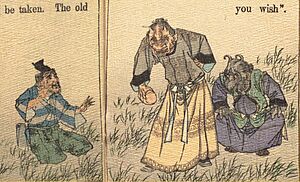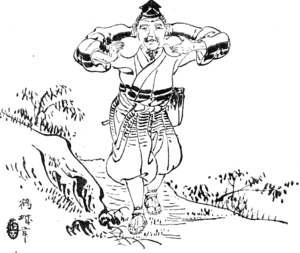Kobutori Jiisan facts for kids
"Kobutori Jiisan" (こぶとりじいさん, Kobutori jīsan) meaning "Lump-removing Old Man" is a famous Japanese folktale. It tells the story of an old man who loses a lump on his face. This happens after he joins a lively party of oni (Japanese demons or ogres) who are singing and dancing.
This tale is a version of a story from an old book called Uji Shūi Monogatari. That book was put together in the early 1200s. The original story was about a woodcutter who gathered firewood.
Contents
The Story of Kobutori Jiisan
There once was an old man who had a large lump on the right side of his face. Some stories say it was as big as a tennis ball. Others describe it as the size of a peach.
One day, the old man went into the mountain to cut wood. Suddenly, it started to rain heavily. He quickly found shelter inside a hollow part of a large tree. While hiding, he saw something amazing. A group of strange beings gathered nearby. Some had only one eye, and some had no mouth. These were the oni, which are like powerful demons or ogres in Japanese stories.
The oni lit a huge bonfire that made the night as bright as day. They began to drink sake (rice wine), sing, and dance with great energy. The old man was scared at first, but he loved to dance. He couldn't help but join in the fun! He stepped out and danced with the oni.
The oni were very entertained by the old man's dancing. Their leader wanted him to come back the next day for another performance. To make sure he returned, the oni decided to keep something valuable from him as a promise. They chose the lump on his face! The oni then magically removed the lump. The old man was overjoyed! The lump was gone, and his cheek felt perfectly normal.
The Envious Neighbor
Next door to the first old man lived another old man. He also had a big lump, but it was on his left cheek. When he heard his neighbor's amazing story about losing his lump, he became very jealous. He wanted the same thing to happen to him.
So, the second old man asked his neighbor if he could take his place. He wanted to perform for the oni the next night. The first old man agreed. The second old man went to the same tree hollow and waited. Soon, the oni gathered again. The chief demon was very excited, expecting another great dance.
However, the second old man was not as good at dancing as the first. His performance was a big disappointment to the oni. The demons became angry. They told him to take his lump back and leave. Then, they threw the first old man's lump onto the second old man's face. It stuck right onto his clean cheek! The second old man returned home very sad and embarrassed. Now, he had two lumps on his face instead of one.
Where the Story Comes From
The story of Kobutori Jiisan can be found in a collection of tales called Uji Shūi Monogatari. This book was put together in Japan in the early 1200s. The medieval version of the story is sometimes called "How Someone Had a Wen Removed by Demons."
In that older version, the man is clearly a "woodcutter" who earned his living selling firewood. The oni are described in many ways. Some are red and wear blue, while others are black and wear red loincloths. Some have only one eye, and some have no mouth. The old story ends with a simple lesson: be careful of envy. It also mentions that the lump was the size of an orange (大柑子, ōkōji). This large lump made it hard for him to work with other people.
Different Versions of the Story
There are many different versions of the Kobutori Jiisan story.
- In 1871, A. B. Mitford shared a version called "The Elves and the Envious Neighbour." In his story, both men have a lump on their forehead. The second man gets another lump because the elves mistake him for the first man. This version also teaches a lesson about envy.
- Another version, called The tumor doubled (瘤二つ, Kobu futatsu), was collected by Kunio Yanagita. In this tale, a priest has a tumor above his eye. Tengu (long-nosed demons) take his tumor. They then give it to a second priest who also has a tumor. Even though the second priest's dancing was good, he still ended up with two tumors.
Similar Stories Around the World
The Kobutori tale is similar to many other stories found in different cultures. It is often classified as a type of story where "Little People" (like fairies or goblins) give gifts.
Asian Similarities
- China: A similar story can be found in a Chinese book from 1611 called Xiaolinping. Another Chinese version appeared in a book in 1749.
- Korea: Many similar stories also exist in Korea. In one Korean version, the first old man tricks the goblins (called dokkaebi). He sells his lump to them, saying it gives him a beautiful singing voice. The second old man is also a good singer, but he receives the useless lump that the goblins took from the first man. Some scholars believe the story came to Korea from Japan during the time Japan ruled Korea (1910–1945). However, other scholars point to an older Korean tale from 1892, "The Story of Hok Lee and the Dwarfs," which suggests the story might have been in Korea even earlier.
European Similarities
- Ireland: In 1875, a man named Charles Wycliffe Goodwin noticed that the Japanese "Kobutori" tale was very much like an Irish story called "The Legend of Knockgrafton." This Irish tale was published around 1825. In the Irish story, fairies sing the names of the first few days of the week. The second hunchback upsets them by adding more days.
- France: A similar story from a region in France called Picardy also has the same idea. Fairies sing the beginning days of the week, and a second hunchback makes them angry by adding more days.



